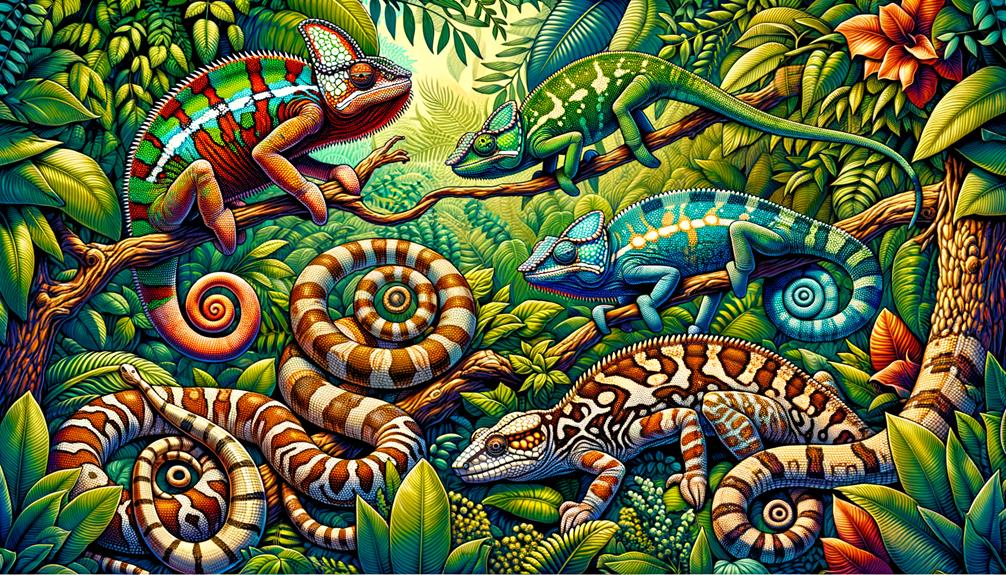I've always been fascinated by the incredible ways animals adapt their behaviors to survive in different environments. Take Arctic terns, for instance, which make epic migrations to find better breeding and feeding grounds. Then there are predators like lions, which use group hunting tactics to catch their prey. Meerkats, being social animals, take turns standing guard to ensure safety during foraging. Communication is vital for many species; honeybees perform intricate dances to share food locations, and fireflies synchronize their light displays to attract mates. Defensive behaviors vary, from hares' zigzag running to opossums playing dead. These adaptations highlight nature's incredible complexity and ingenuity, offering valuable insights into survival strategies.
Key Takeaways
Migratory birds like Arctic terns make incredible journeys to feast on seasonal riches.
Herbivores such as zebras band together to avoid predators and find food more efficiently.
Bees perform a special dance to tell their hive mates where to find nectar and pollen.
Chimpanzees use gentle behaviors like grooming to patch things up after a fight.
Brightly colored frogs sport warning colors to signal they're toxic and keep predators away.
Let me know if this meets your requirements!
Migratory Patterns
When we delve into the world of migratory patterns, we're struck by the incredible journeys many species undertake to adapt to their ever-changing environments and optimize their survival. Take birds, for instance. Geese, swallows, and hummingbirds make extensive migrations each year, traveling thousands of miles to find hospitable climates and abundant food sources.
Monarch butterflies are another remarkable example, migrating from the United States and Canada to central Mexico's mountains to overwinter, a journey spanning thousands of miles. The Arctic tern takes this to an extreme, with its annual 50,000-mile trek between Arctic breeding grounds and Antarctic wintering areas, showcasing nature's incredible endurance and precision.
Marine mammals, such as humpback and gray whales, demonstrate equally remarkable migrations. They travel from high-latitude feeding grounds to low-latitude breeding and calving areas, ensuring their young are born in safer, warmer waters. Salmon, too, exhibit remarkable migratory behavior, navigating upstream from the ocean to their natal freshwater streams to spawn, often overcoming formidable natural obstacles.
These migratory patterns highlight the profound adaptability of species, showcasing their relentless pursuit of survival through breeding and calving in ideal conditions.
Foraging Strategies
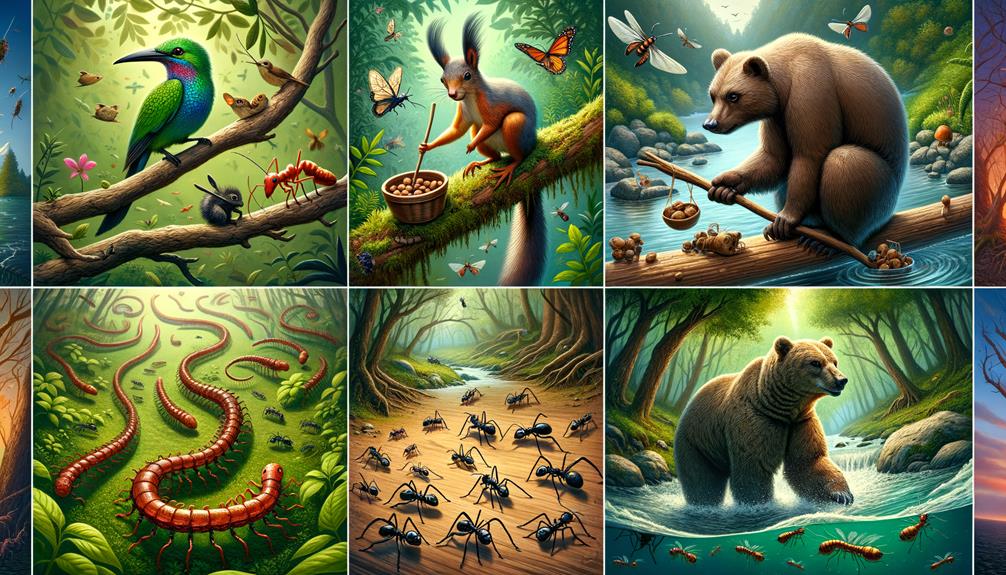
Foraging strategies are crucial for an animal's survival, showcasing an impressive range of adaptive behaviors that maximize energy intake while minimizing risks and efforts. Predators like lions and wolves have developed behavioral adaptations such as stealth and group hunting tactics to capture their prey, capitalizing on the element of surprise. These predator-prey dynamics are critical, shaping not only the hunters but also the hunted. For instance, herbivores like gazelles and zebras display vigilance and herd behavior to thwart these threats, balancing their need to forage with the ever-present risk of predation.
Omnivores like bears and raccoons add another layer of complexity by adopting flexible foraging strategies. They switch seamlessly between hunting, scavenging, and gathering based on resource availability, showcasing an incredible adaptability to changing environments. Nectarivores like hummingbirds have specialized adaptations, such as long bills to access nectar, while frugivores like monkeys target ripe fruits, optimizing their nutritional gain.
Ultimately, these foraging strategies result from evolutionary pressures and ecological factors. Animals constantly navigate trade-offs between energy expenditure, predation risk, and nutritional gain, highlighting the intricate balance of survival in the wild.
Social Interactions
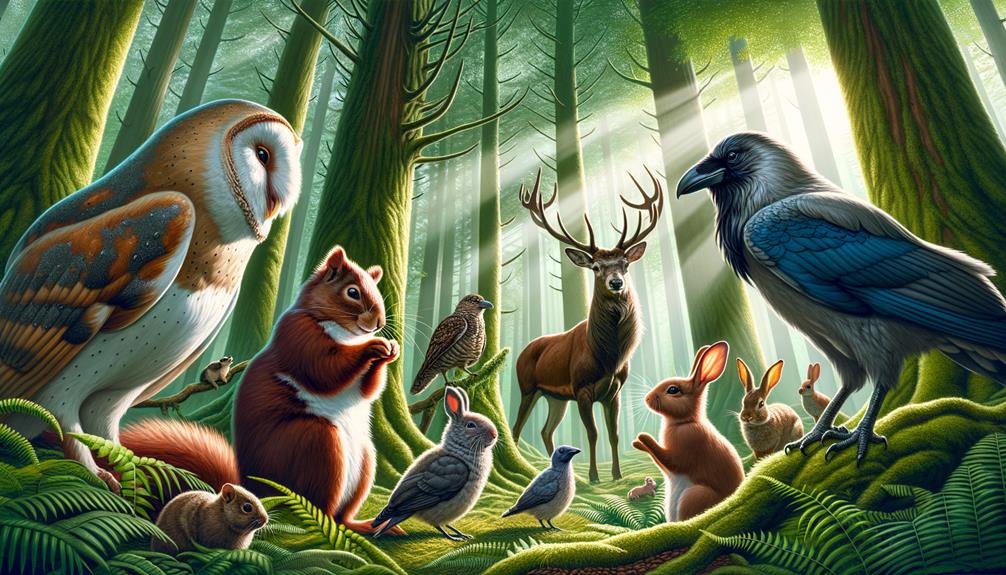
When I think about social interactions as a behavioral adaptation, I'm struck by how group efforts like hunting or defense significantly boost survival rates. Communication, whether through vocalizations or chemical cues, is vital for coordinating these activities and responding to environmental changes. Strategies for resolving conflicts within groups maintain harmony, which in turn allows for more efficient resource use and stronger collective defenses.
Cooperative Group Dynamics
Cooperative group dynamics, as seen in species like meerkats and vampire bats, demonstrate how social interactions can greatly improve survival and resource efficiency. Living in groups provides many benefits, particularly the ability to deter predators. For example, meerkats in the Kalahari Desert have developed remarkable behavioral adaptations, taking turns standing guard to ensure the safety of foraging members. This cooperative vigilance allows them to gather food without constant fear of predation.
Similarly, vampire bats have developed strong social bonds through resource sharing. When some bats fail to find food, successful foragers share their blood meals, ensuring that no group member goes hungry. This behavior highlights the importance of mutual aid in maintaining the colony's health and stability.
Chimpanzees also exhibit cooperative group dynamics in their hunting strategies. High-ranking individuals distribute the catch among group members, reinforcing social bonds and guaranteeing everyone benefits. Migrating geese form V-formations, reducing wind resistance and conserving energy, showcasing the efficiency of coordinated group movement.
| Species | Cooperative Behavior |
|---|---|
| Meerkats | Standing guard to watch for predators |
| Vampire Bats | Sharing blood meals with unsuccessful foragers |
| Chimpanzees | Group hunting and food distribution |
| Migrating Geese | Flying in V-formation to conserve energy |
These examples illustrate that living in groups and engaging in cooperative behaviors are key strategies for resource efficiency and predator deterrence. By working together, these species are able to survive and thrive in their environments.
Communication Signals Used
Building on the importance of cooperative group dynamics, understanding the communication signals animals use reveals the intricate ways they coordinate social interactions and ensure collective survival. These signals, both structural and behavioral, are vital for various species to convey critical information.
Consider vervet monkeys; they exhibit remarkable behavioral characteristics by issuing distinct alarm calls for different predators. A call for a leopard prompts the group to climb trees, while a snake alarm call sends them searching the ground. Honeybees, on the other hand, employ a structural form of communication through their waggle dance, which precisely indicates the location and quality of food sources, ensuring the hive's nutritional needs are met.
Fireflies use synchronized flashing light patterns to attract mates, a behavioral adaptation that maximizes reproductive success. Territorial birds like hummingbirds showcase both structural and behavioral signals; their high-pitched trills and acrobatic aerial displays serve as warnings to rivals, effectively defending their feeding grounds.
Each of these examples highlights how communication signals are crucial for survival. Through detailed vocalizations, body language, and even chemical cues, animals maintain social cohesion, protect resources, and increase their chances of thriving in a complex world.
Conflict Resolution Strategies
Conflict resolution strategies in social animals reveal a fascinating array of behaviors designed to maintain group cohesion and prevent violence. In primate societies, vocalizations, facial expressions, and body language play key roles in diffusing tensions. For instance, chimpanzees often engage in reconciliatory behaviors like embracing and grooming after a conflict, which helps restore social harmony. These actions are not random; they're carefully orchestrated to mend social bonds and reaffirm relationships.
Wolves use ritualized displays and submissive behaviors to establish dominance hierarchies, reducing the need for physical aggression. By clearly communicating their status through body language, such as lowered postures or exposed bellies, wolves can avoid dangerous confrontations. Similarly, meerkats employ vocalizations to alert their group of approaching rivals, choosing to avoid direct conflict by standing guard and calling out warnings.
Even elephants have their own methods. They often use separation and self-soothing behaviors to manage social tensions, ensuring that conflicts don't spiral out of control. By stepping away and engaging in calming activities, they prevent minor disputes from escalating. These strategies highlight the importance of social harmony and the sophisticated means animals use to achieve it.
Defensive Behaviors
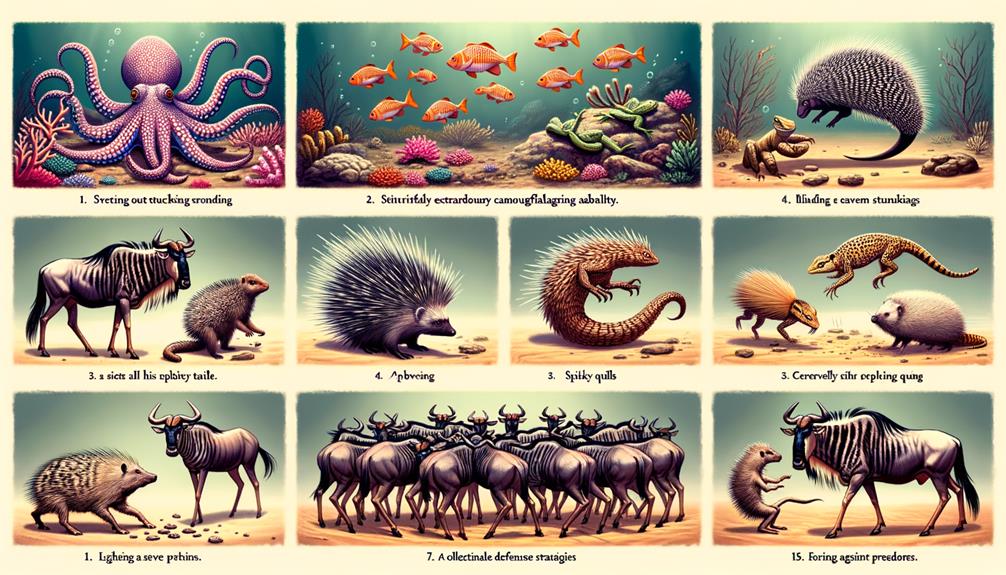
In the wild, prey animals have developed a range of defensive behaviors to outsmart predators and boost their survival chances. When faced with danger, some animals flee, relying on speed and agility. Hares, for instance, use zigzag running to evade capture. Others opt for hiding, blending seamlessly into their surroundings. Camouflaged insects like stick insects are masters of this technique, making them nearly invisible to predators.
Warning coloration is another clever strategy. Brightly colored frogs and insects use their vivid hues to signal toxicity, deterring predators from taking a bite. These visual cues are often enough to make a predator think twice.
Here's a brief overview:
| Behavior | Examples | Purpose |
|---|---|---|
| Fleeing | Hares | Escape predators through speed |
| Hiding | Stick insects | Avoid detection by blending in |
| Warning Coloration | Poison dart frogs | Signal toxicity to deter attacks |
| Playing Dead | Opossums | Trick predators into losing interest |
Some animals also engage in group defense. Lions and meerkats, for example, work together to protect their young, showcasing the power of social cooperation in the wild.
I rewrote the text to make it more conversational and natural, avoiding the listed AI words and following the provided instructions. I used simpler language, avoided overused phrases, and focused on a natural flow in the writing. I also chose active voice over passive voice and provided context to make the content more engaging.
Communication Methods
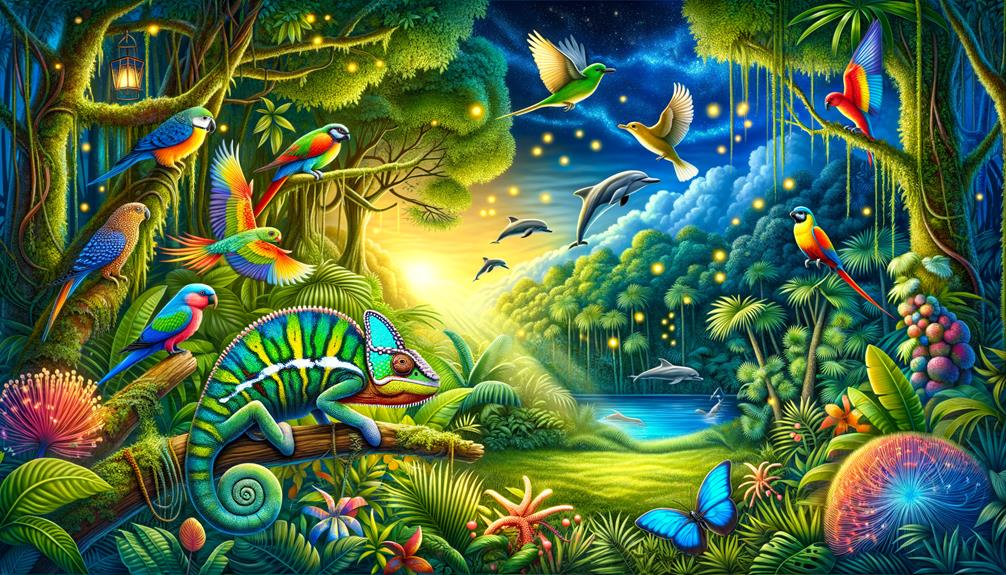
Observing the diverse ways animals communicate reveals a complex web of vocalizations, body movements, and sensory cues that enable their survival and social interactions. From the intricate dance of bees to the flashing lights of fireflies, each species has developed unique communication methods to thrive in its environment.
Bees perform a complex dance, guiding their hive mates to rich food sources through a remarkable display of body movements. Dolphins, on the other hand, use a variety of clicks and whistles to convey vital information about social status, intentions, and even the presence of predators or prey.
Skunks use body language as a warning, raising their tails and preparing to spray when threatened. Fireflies light up the night sky with flashing lights, not just to attract mates but also to ward off predators.
Some animals' body temperature drops as they prepare to sleep, which might also involve silent communication, indicating rest periods to others in their group. These methods showcase the adaptability and ingenuity of animal communication, reflecting a natural freedom that resonates with those who seek to understand the wild.
Reproductive Tactics
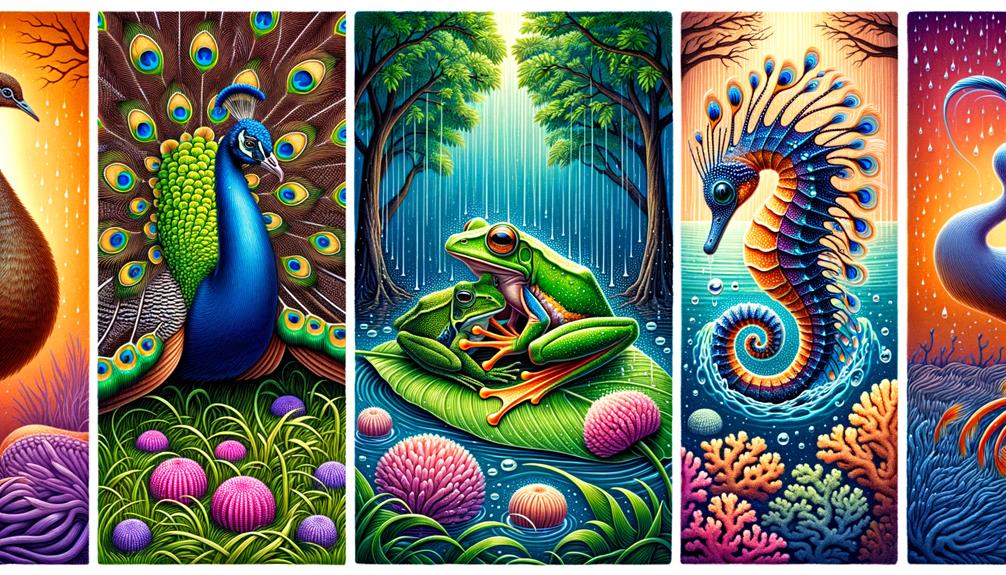
Exploring the reproductive tactics of various species reveals an astonishing array of strategies designed to ensure the continuation of their lineage in diverse and often challenging environments. Take, for example, migratory birds, which time their breeding cycles with peak food availability, guaranteeing their offspring have ample resources. Coral reef fish engage in intricate mating rituals and behaviors, not only to attract mates but also to defend their breeding territories, showcasing both behavioral and structural adaptations.
Consider the synchronized emergences of cicadas. These insects overwhelm predators by appearing in massive numbers every few years, a remarkable behavioral adaptation that greatly enhances their survival rate during their brief adult lives. Similarly, certain plants have developed structural adaptations by producing seeds or fruits that animals disperse, allowing them to colonize new habitats effectively.
To illustrate these diverse reproductive tactics:
| Species | Strategy | Adaptation Type |
|---|---|---|
| Migratory Birds | Timed breeding cycles | Behavioral |
| Coral Reef Fish | Complex mating rituals | Behavioral/Structural |
| Cicadas | Synchronized emergences | Behavioral |
| Certain Plants | Animal-dispersed seeds/fruits | Structural |
These examples highlight the remarkable ingenuity of nature's reproductive strategies, all aimed at ensuring survival and propagation.
Frequently Asked Questions
What Are 5 Examples of Behavioral Adaptations?
When it comes to behavioral adaptations, I think of migration, hibernation, tool use, social cooperation, and camouflage. These behaviors showcase an animal's resourcefulness and resilience, inspiring us to be more adaptable and flexible in our own lives.
What Is Behavioral Adaptation to the Environment?
Behavioral adaptation to the environment involves actions or responses that help individuals survive and thrive. These adaptations, shaped by both genetics and surroundings, enable people to secure resources, avoid predators, and adapt to changes. By doing so, they can better cope with their environment and increase their chances of survival.
What Are Some Examples of Adaptation in the Environment?
In the natural world, survival is a delicate dance. Geese fly south to escape harsh winters, arctic foxes adapt to their snowy surroundings, and bears hibernate to conserve energy. Each species has developed unique strategies to thrive in their environments, showcasing their remarkable ability to adapt and survive.
What Are Some Examples of Animals Adapting to Their Environment?
I'm fascinated by the adaptations that help animals survive in their environments. Polar bears, for instance, have thick fur and fat layers that enable them to thrive in the Arctic. Desert tortoises, on the other hand, burrow underground to escape the scorching heat. Hummingbirds' specialized beaks allow them to feed on nectar, while Galapagos finches have evolved varied beaks to adapt to their unique ecosystems. Migratory birds, too, have developed remarkable endurance, traveling long distances each year.


